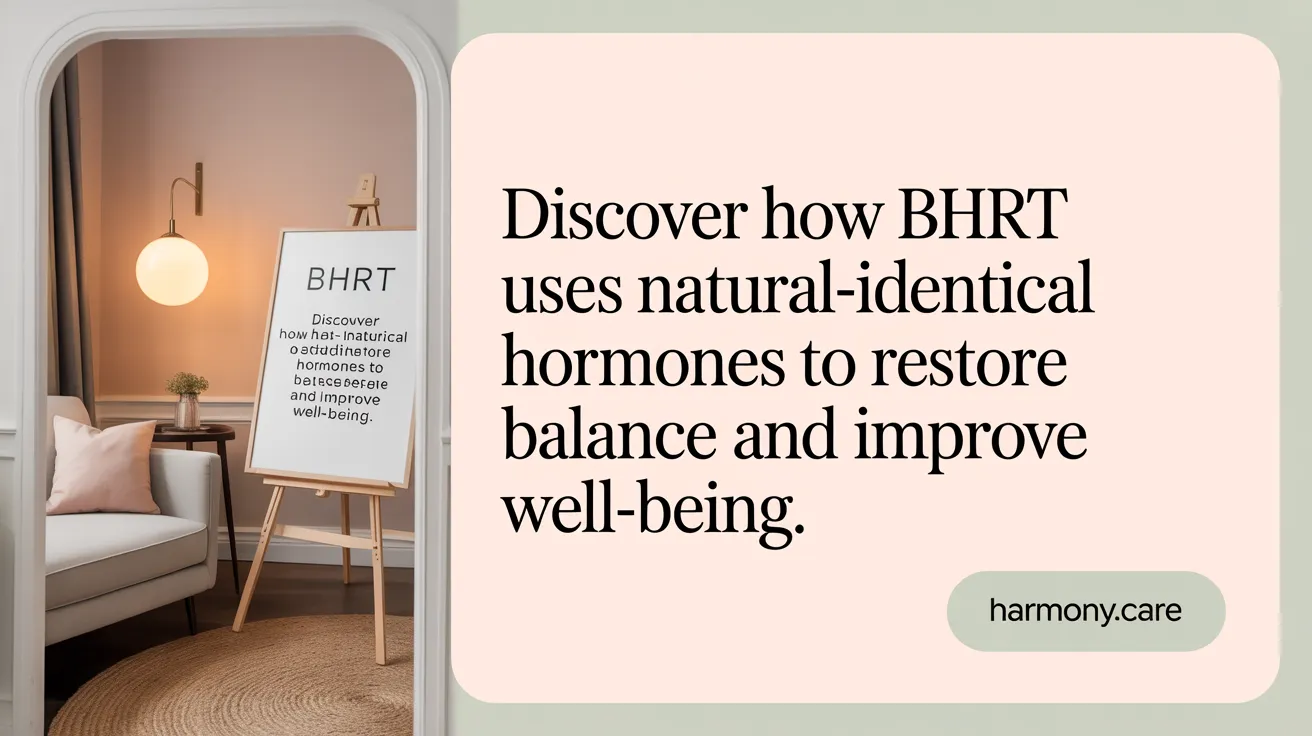Understanding BHRT: Balancing Hormones Naturally
Bioidentical Hormone Replacement Therapy (BHRT) has gained attention as a treatment option for menopausal and hormonal imbalance symptoms. Designed to use hormones chemically identical to those our bodies produce, BHRT aims to restore hormone balance and improve quality of life. However, with varying formulations and significant safety considerations, it's essential to navigate the benefits and risks carefully. This article delves into the nature of BHRT, its health advantages, safety profiles, regulatory issues, administration methods, and the clinical decision-making process.
What Is Bioidentical Hormone Replacement Therapy and Its Purpose?

What is bioidentical hormone replacement therapy (BHRT) and what is its general purpose?
Bioidentical hormone replacement therapy (BHRT) involves using hormones that are chemically identical to those naturally produced by the human body to address hormonal imbalances and related symptoms. It is commonly employed to help women and men manage issues associated with aging, such as menopause and andropause. Bioidentical Hormone Replacement Therapy
These hormones, including estrogen, progesterone, and testosterone, are often derived from plant sources like yams or soybeans. They can be administered through various forms such as pills, patches, creams, gels, injections, and pellets inserted under the skin. Bioidentical Hormone Replacement Therapy: Forms and Uses
The main goal of BHRT is to restore hormonal balance, which can alleviate symptoms like hot flashes, night sweats, vaginal dryness, mood swings, sleep disturbances, and decreased libido. Properly balanced hormones can also support bone health, cognitive function, and overall well-being. Benefits of BHRT and Symptom Relief
However, it is important to distinguish between FDA-approved bioidentical hormones, which have undergone rigorous safety and efficacy testing, and compounded bioidentical hormones prepared by pharmacists based on individual prescriptions. The latter are not regulated by the FDA and pose potential safety risks due to variability in dose and purity. Compounded Bioidentical Hormones and FDA Oversight
Because hormone levels and responses vary among individuals, BHRT must be closely supervised by a healthcare provider. Regular medical assessments are crucial to monitor hormone levels, minimize side effects, and adjust dosages if needed. Despite its popularity, BHRT should be used with caution, ensuring treatment from reputable sources and under medical guidance. Safety and Monitoring in BHRT
Benefits and Health Advantages of BHRT for Menopause and Hormonal Imbalances
 Bioidentical hormone replacement therapy (BHRT) provides several significant health benefits for women experiencing menopause or hormonal imbalances. One of the primary advantages is symptom relief; many women report alleviation of hot flashes, night sweats, vaginal dryness, mood swings, and sleep difficulties after beginning BHRT. These symptoms can severely impact quality of life, and BHRT offers a targeted approach to restoring comfort and normalcy.
Bioidentical hormone replacement therapy (BHRT) provides several significant health benefits for women experiencing menopause or hormonal imbalances. One of the primary advantages is symptom relief; many women report alleviation of hot flashes, night sweats, vaginal dryness, mood swings, and sleep difficulties after beginning BHRT. These symptoms can severely impact quality of life, and BHRT offers a targeted approach to restoring comfort and normalcy.
In addition to symptom management, BHRT supports bone health by helping to maintain or increase bone density, which is crucial in preventing osteoporosis and related fractures. This is especially important as declining estrogen levels during menopause significantly accelerate bone loss (source).
Furthermore, BHRT has been associated with improvements in mood and cognitive function. Many women notice enhanced emotional stability, reduced anxiety, better concentration, and sharper memory, contributing to overall mental well-being (source). The therapy may also promote healthier skin by improving elasticity and reducing the appearance of wrinkles, thus supporting a youthful appearance (source).
Sexual health is another area where BHRT can be beneficial. It often helps to restore libido and reduce discomfort during intercourse caused by vaginal atrophy. Overall, BHRT offers a comprehensive approach to restoring hormonal balance, which not only alleviates immediate menopausal symptoms but also supports longer-term health (source).
While the effects of BHRT are promising, individual responses vary. Optimal safety and efficacy depend on correct formulation and application, which should be overseen by qualified healthcare providers. Regular monitoring ensures hormone levels are appropriately balanced, reducing the risk of adverse effects (source). In summary, BHRT can enhance quality of life, reduce disease risks, and support physical and mental health, making it a valuable option for many women facing hormonal challenges (source).
Comparing Bioidentical Hormones and Traditional Hormone Replacement Therapy

How do bioidentical hormones compare to traditional hormone replacement therapy (HRT) in terms of safety and efficacy?
Bioidentical hormones are chemically identical to the hormones naturally produced by the human body and are used in both FDA-approved medications and compounded formulations. They are derived from plant sources and tailored to mimic the body's own hormones.
While some proponents claim that bioidentical hormones are safer, more natural, or more effective than traditional synthetic hormone replacement therapy (HRT), scientific evidence does not support these claims. Numerous medical organizations, including the FDA and The Endocrine Society, emphasize that there is no conclusive proof that compounded bioidentical hormones are safer or more effective.
FDA-approved bioidentical hormones are produced under strict quality standards, ensuring consistent dosing, purity, and safety. In contrast, compounded bioidentical hormones, prepared by pharmacies upon individual prescriptions, often lack rigorous testing and regulation. This variability can lead to differences in hormone dose and purity, raising safety concerns.
Both approaches carry potential risks such as blood clots, stroke, breast cancer, and cardiovascular issues. The evidence indicates that neither bioidentical nor traditional HRT confers a clear safety advantage, and the decision to use either should be based on individual health conditions and in consultation with healthcare professionals (source).
The belief that bioidentical hormones are inherently safer or more effective is a myth; their benefits over traditional HRT have not been substantively demonstrated through rigorous clinical trials (more details).
In summary, current research suggests that both bioidentical hormones and traditional HRT have comparable safety profiles when used appropriately, and choosing between them should involve careful consideration of personal health factors and medical guidance (read further).
Risks, Safety Considerations, and Myths of BHRT

What are the risks and safety considerations associated with BHRT, including potential side effects and adverse health outcomes?
Bioidentical hormone replacement therapy (BHRT) carries risks similar to conventional hormone therapies, such as increased likelihood of blood clots, stroke, gallbladder disease, and possibly heightened risks of certain cancers like breast and endometrial cancer, particularly with long-term use. Compounded bioidentical hormones, which are not approved by the FDA and do not undergo standard safety testing, pose additional concerns due to their variable quality, purity, and dosage. Common side effects reported by users include breast tenderness, mood swings, headaches, weight gain, skin irritations, and menstrual spotting. The overall health risks depend on the hormone type, dose, duration of therapy, and individual health factors. Regular monitoring by healthcare professionals is essential to optimize safety and efficacy. Personalized treatment plans, with careful oversight, are recommended to balance symptom relief with potential health risks, especially for women with existing health conditions.
What scientific evidence exists regarding the effectiveness and safety of BHRT, and what are common myths or misconceptions?
Current research suggests that bioidentical hormone replacement therapy (BHRT) can provide benefits comparable to traditional hormone therapy for relieving menopausal symptoms like hot flashes, night sweats, and mood disturbance. Many FDA-approved bioidentical hormones, such as estradiol and progesterone, have undergone safety testing and are considered effective options. However, compounded BHRT formulations, prepared by pharmacies without FDA oversight, lack robust clinical trial data on safety and efficacy, raising concerns about their reliability. Both FDA-approved and compounded BHRT therapies carry certain risks, including blood clots, stroke, and cancers. Myths that BHRT is entirely natural, safer, and free of risks are unsupported by scientific evidence. These claims often originate from marketing rhetoric rather than rigorous research. Many so-called natural or compounded products can contain unregulated or inconsistent hormone doses, and the use of saliva hormone testing to guide dosing is not scientifically validated. Healthcare providers and patients should rely on evidence-based information and consult knowledgeable clinicians to make informed decisions about hormonal treatments.
Administration, Regulation, and Quality Control of BHRT
Bioidentical Hormone Replacement Therapy (BHRT) can be administered through multiple methods, each suited to different patient needs and preferences. Common delivery forms include pills taken orally, topical patches applied to the skin, creams and gels rubbed onto the skin, injections, and hormone pellets implanted under the skin. The choice of method depends on factors such as symptom severity, convenience, absorption rates, and safety considerations (Bioidentical Hormones Overview, Bioidentical Hormone Replacement Therapy: Benefits, Bioidentical Hormone Replacement Therapy).
Personalized treatment plans are a typical part of BHRT. Healthcare providers often tailor hormone doses based on laboratory blood or saliva tests and individual symptom assessments. Regular monitoring allows clinicians to adjust doses, improve efficacy, and minimize side effects. The goal is to restore hormonal balance gradually and maintain it steadily, especially with pellet therapy, which provides a slow, consistent hormone release over several months (Customized Bioidentical Hormone Pellets, Personalized BHRT Treatment).
Differences between FDA-approved and compounded BHRT are critical to understand. FDA-approved bioidentical hormones have undergone rigorous safety and efficacy testing, are manufactured under strict quality controls, and meet standardized potency and purity levels. Examples include micronized progesterone and estradiol. Conversely, compounded bioidentical hormones are custom-formulated by pharmacists according to individual prescriptions, often without FDA oversight. These preparations are mixed in compounding pharmacies and are not subject to the same safety standards, leading to variability in hormone concentrations and potential contamination (Compounded Bioidentical Menopausal Hormone Therapy, Compounded Bioidentical Hormone Therapy Risks, Bioidentical hormones and safety).
Regulatory considerations are vital. While laws like the 2013 Drug Quality and Security Act aim to increase oversight of compounding pharmacies, many compounded products still lack consistent quality control. They are not evaluated by the FDA for safety or efficacy before sale, which raises concerns about contamination, incorrect dosing, and the presence of unapproved additives. Major health organizations generally recommend using FDA-approved hormones, as they adhere to established manufacturing standards (Endocrine Society on compounded hormones, Mayo Clinic on bioidentical hormone safety).
Possible risks linked to compounded hormones include unpredictable hormone levels, increased chance of adverse effects, and safety concerns such as bacterial contamination or incorrect hormone concentrations. These issues emphasize the importance of selecting reputable pharmacies that comply with regulations and quality standards (Safety concerns of compounded bioidentical hormones, Quality control in compounded bioidentical products).
In summary, patients considering BHRT should discuss the administration method and source with their healthcare provider. Emphasizing the importance of FDA-approved products and meticulous monitoring can help ensure safe and effective treatment. Choosing therapies from regulated sources minimizes risks and supports optimal symptom management and hormone balance (Bioidentical Hormone Replacement Therapy Overview, Consulting healthcare providers about hormone therapy).
Clinical Considerations and Impact of BHRT on Skin and Overall Health
Factors clinicians consider when prescribing BHRT
When recommending bioidentical hormone replacement therapy (BHRT), healthcare providers evaluate a patient's age, medical history, current health conditions, and symptom severity. They also assess specific hormone deficiencies, such as estrogen, progesterone, or testosterone levels, and consider individual risk factors for conditions like breast cancer, cardiovascular disease, and osteoporosis. It is important to distinguish FDA-approved bioidentical hormones, which undergo rigorous safety and efficacy testing, from compounded formulations, which lack standardization and comprehensive regulation.
Patients should be advised to prioritize FDA-approved options and approach claims of natural or safer compounded hormones with caution. Treatment decisions are primarily symptom-driven rather than solely based on hormone level testing, as hormone fluctuations are natural and salivary testing is unreliable. Shortest effective treatment duration and dosing tailored to symptom relief are recommended. Shared decision-making, informed by the latest evidence and individual health profiles, ensures safer and more effective therapy choices.
Patient decision-making and shared responsibility
Active involvement of patients in their treatment plans fosters better outcomes. Patients should be informed about potential risks, such as blood clots, cancer, and cardiovascular concerns, and understand that long-term safety data for compounded BHRT are limited. Clarifying the difference between FDA-approved and compounded hormones, alongside emphasizing the importance of quality sources, helps prevent misconceptions.
Healthcare providers should work collaboratively with patients, considering their values, lifestyle, and preferences, to select the most appropriate hormone therapy. Regular follow-ups and monitoring, including symptom assessment and, when appropriate, laboratory tests, support safe ongoing management. Educating patients on the lack of evidence supporting claims of youth preservation or weight loss benefits further guides realistic expectations. See FDA and clinical guidelines on compounded bioidentical hormones and education on bioidentical hormone myths.
BHRT’s role in skin aging and appearance
Estrogens play a vital role in skin health by stimulating dermal fibroblasts, increasing collagen production, and maintaining skin thickness and hydration. Through BHRT, women may notice improved skin elasticity, fewer wrinkles, and a more youthful appearance. Estrogen’s biological activity helps delay visible signs of aging caused by collagen breakdown and reduced skin cell turnover. See research on hormone therapy and skin aging.
Enhanced skin tone and texture are additional benefits associated with hormonal balancing provided by BHRT. These effects not only promote aesthetic improvements but also contribute to improved self-esteem and confidence. Besides skin benefits, BHRT supports overall health by alleviating menopausal symptoms, improving bone density, mental clarity, and cardiovascular health.
Broader effects on bone, mood, cognitive and cardiovascular health
BHRT may significantly affect bone health by promoting osteoblast activity, which helps combat osteoporosis and reduce fracture risk. The therapy can stabilize mood swings, reduce anxiety, and improve mental clarity by restoring hormonal balance. Cognitive benefits include better memory and focus, potentially lowering the risk of neurodegenerative conditions.
Cardiovascular health may improve with appropriate hormone therapy, especially through transdermal formulations that minimize clot risks. Estrogens also contribute to lipid profile improvements, further reducing cardiovascular risks. Nonetheless, careful patient selection and monitoring are imperative, as improper dosing or unregulated compounded hormones may negate these benefits. See Mayo Clinic info on bioidentical hormone safety and Menopause Society's hormone therapy overview.
Importance of monitoring and individualized dosing
To ensure safety and maximize benefits, regular monitoring of hormone levels and health status is essential. Blood, saliva, or urine tests can guide dose adjustments, although the FDA advises against using these measurements to strictly dictate therapy due to natural hormonal fluctuations. Refer to clinical consensus on compounded BHRT and lab testing.
Personalized treatment plans, which include starting with the lowest effective dose and adjusting based on symptom response and side effects, are the cornerstone of effective BHRT. This approach helps mitigate risks such as hormonal imbalance, increased cancer risk, and cardiovascular complications. For treatment strategies and monitoring, see Cleveland Clinic BHRT management.
Long-term effect uncertainties and ongoing research
While short-term benefits of BHRT for menopausal symptoms are well-documented, long-term safety remains less certain. Studies indicate that FDA-approved bioidentical hormones have safety profiles comparable to traditional hormone therapy when used appropriately.
However, compounded BHRT formulations, lacking standardization and rigorous testing, pose unknown long-term risks, such as increased probability of contamination, inconsistent dosing, and unapproved ingredient inclusion. Ongoing research aims to clarify these uncertainties, but clinicians and patients must base decisions on current evidence, favoring FDA-regulated products and vigilant monitoring. See also Endocrine Society position on compounded bioidentical therapy and NCBI research on risks of compounded HRT.
In conclusion, BHRT offers promising symptom relief and potential health benefits, but its safety profile underscores the importance of careful selection, professional guidance, and continuous evaluation to optimize outcomes and minimize risks.
Making Informed Decisions on Bioidentical Hormone Replacement Therapy
Bioidentical Hormone Replacement Therapy presents a promising avenue for managing menopause and hormonal imbalance symptoms by using hormones chemically identical to the body's own. While offering benefits such as symptom relief, improved bone health, and better skin quality, BHRT carries risks similar to traditional hormone therapies, including potential cardiovascular and cancer risks. A critical distinction exists between FDA-approved bioidentical hormones, which undergo rigorous testing, and compounded formulations, which may lack consistent regulation and safety assurances. Patients are encouraged to seek care from knowledgeable healthcare providers who can guide therapy choices based on individual health profiles and the latest scientific evidence. Ultimately, personalized, evidence-based approaches combined with vigilant monitoring offer the best path to safely harnessing the benefits of BHRT.
